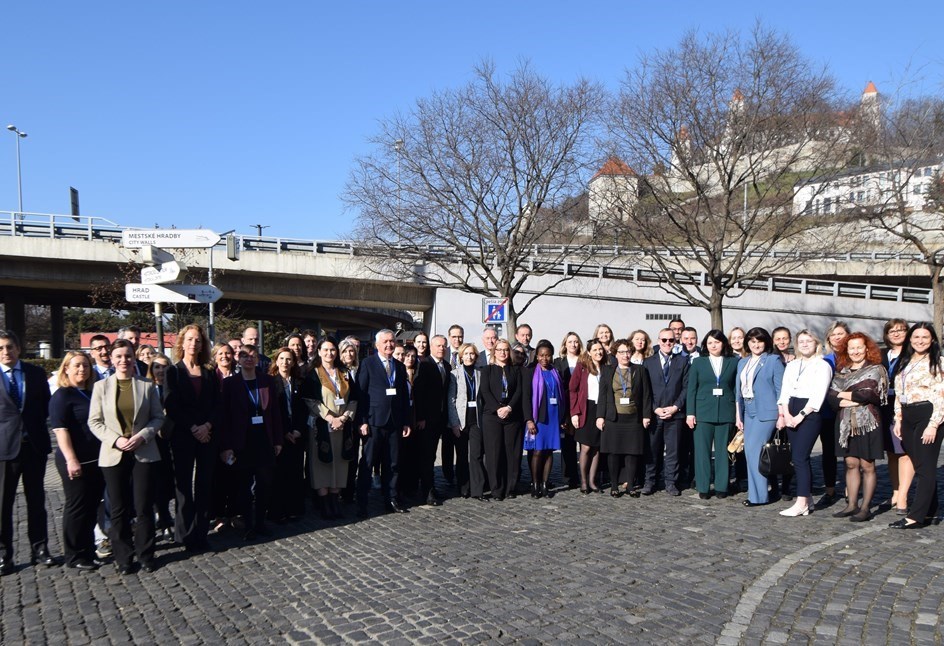JOINT MEETING OF EUROSAI STRATEGIC OBJECTIVE 1 AND STRATEGIC OBJECTIVE 2
On 5-6 March, more than 50 participants from 24 European countries gathered in Bratislava, Slovak Republic, to participate in the first joint meeting of representatives implementing EUROSAI Strategic Objective 1 and Strategic Objective 2.
The two-day international event was organized by five SAIs: the SAIs of Lithuania and Germany as co-leads of Strategic Objective 1, the SAIs of Sweden and Poland as co-leads of Strategic Objective 2, and the SAI of Slovakia as the host of the event.
The meeting provided an excellent opportunity to gain insight into the full range of EUROSAI activities and to explore ways to improve cooperation between supreme audit institutions.
Presentations of activities within both EUROSAI strategic objectives also helped to identify synergies between working groups and project groups, and how each group can contribute to the fulfilment of the strategic objectives.
The State Audit Office presented the purpose and objectives of the EUROSAI Ethics Network, of which it is the Chair, its results, challenges and how it intends to overcome current challenges.
During the meeting, a “foresight” exercise was also carried out, which sought to predict what EUROSAI should look like in 2050. This forward-looking exercise encouraged participants to think about how EUROSAI can develop and adapt to future challenges. Another interactive workshop focused on identifying current challenges faced by SAIs themselves and exploring potential activities and projects within the EUROSAI framework to address them. This was particularly valuable in terms of ensuring that future initiatives are driven by real needs and address challenges and priorities in order for EUROSAI to remain relevant and influential.
In addition to reinforcing the importance of collaboration, innovation and shared learning, ensuring that SAIs remain resilient and forward-looking in an ever-evolving public sector environment, the meeting also confirmed that true, meaningful engagement and impact are not determined by size, but by SAIs' commitment, collaboration and willingness to contribute to the wider community.
The two-day international event was organized by five SAIs: the SAIs of Lithuania and Germany as co-leads of Strategic Objective 1, the SAIs of Sweden and Poland as co-leads of Strategic Objective 2, and the SAI of Slovakia as the host of the event.
The meeting provided an excellent opportunity to gain insight into the full range of EUROSAI activities and to explore ways to improve cooperation between supreme audit institutions.
Presentations of activities within both EUROSAI strategic objectives also helped to identify synergies between working groups and project groups, and how each group can contribute to the fulfilment of the strategic objectives.
The State Audit Office presented the purpose and objectives of the EUROSAI Ethics Network, of which it is the Chair, its results, challenges and how it intends to overcome current challenges.
During the meeting, a “foresight” exercise was also carried out, which sought to predict what EUROSAI should look like in 2050. This forward-looking exercise encouraged participants to think about how EUROSAI can develop and adapt to future challenges. Another interactive workshop focused on identifying current challenges faced by SAIs themselves and exploring potential activities and projects within the EUROSAI framework to address them. This was particularly valuable in terms of ensuring that future initiatives are driven by real needs and address challenges and priorities in order for EUROSAI to remain relevant and influential.
In addition to reinforcing the importance of collaboration, innovation and shared learning, ensuring that SAIs remain resilient and forward-looking in an ever-evolving public sector environment, the meeting also confirmed that true, meaningful engagement and impact are not determined by size, but by SAIs' commitment, collaboration and willingness to contribute to the wider community.


